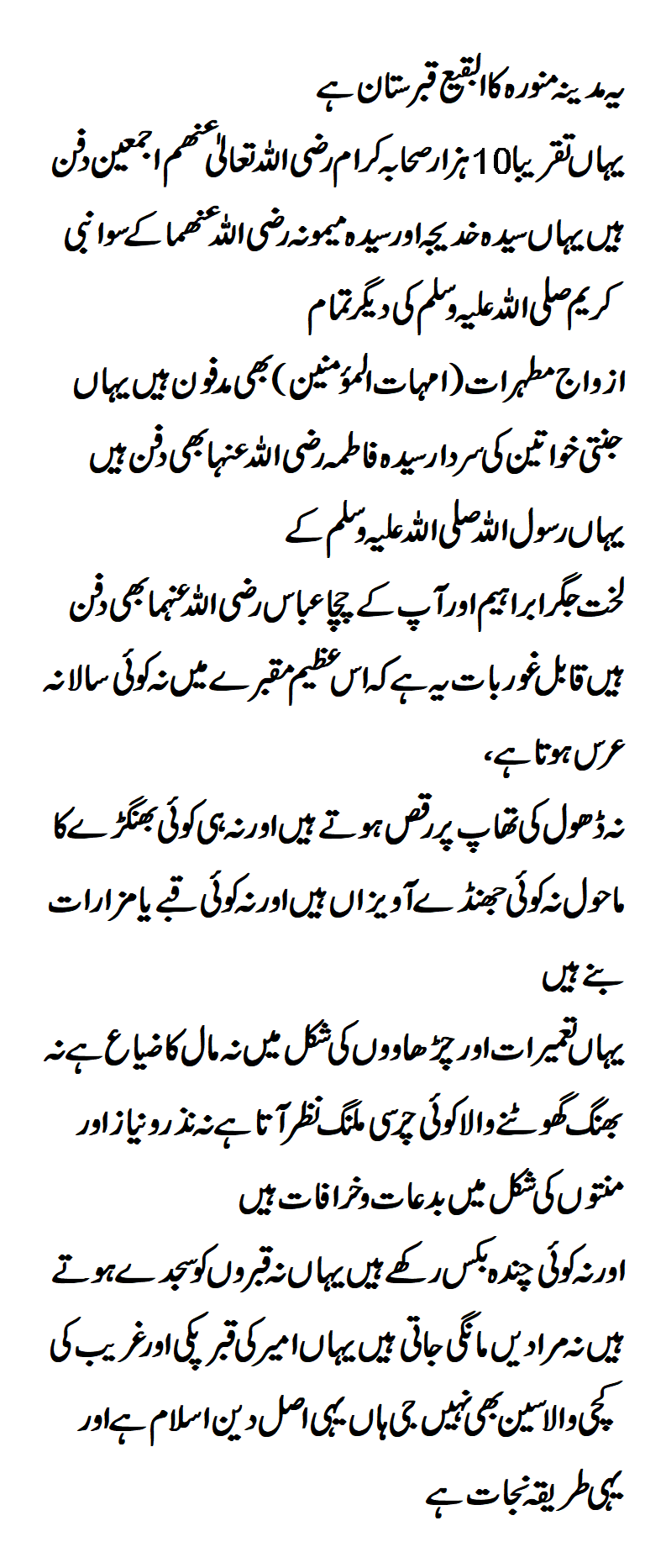This cemetery contains the Graves of the Prophets Grandson IMAM HASAN ibn. ALI(as), his son IMAM ALI ibn. AL-HUSAYN Zainal abidin(as) , & His son IMAM MUHAMMAD BAQER ibn. AI(as)I & IMAM JA’FAR E SADIQ -( PEACE BE UPON THEM) , aunt Fatima bint al-Asad, & many other prominent personalities
On 8th Shawwal, Wednesday, in the year 1345 AH (April 21, 1925), mausoleums in Jannatul al-Baqi (Madina) were demolished by King Ibn Saud. In the same year (1925), he also demolished the tombs of holy personages at Jannat al-Mualla (Makkah) where the Holy Prophet (s)’s mother, wife, grandfather and other ancestors are buried.
Destruction of sacred sites in Hijaz by the Saudi Wahhabis continues even today. According to some scholars what is happening in Hijaz is actually a conspiracy plotted by the Zionists against Islam, under the guise of Tawheed. The idea is to eradicate the Islamic legacy and heritage and to systematically remove all its vestiges so that in the days to come, Muslims will have no affiliation with their religious history.
The Origins of Al-Baqi
Literally “al-Baqi” means a tree garden. It is also known as “Jannat al-Baqi” due to its sanctity, since in it are buried many of our Prophet’s relatives and companions.The first companion buried in al-Baqi was Uthman b. Madhoon who died on the 3rd of Sha’ban in the 3rd year of Hijrah. The Prophet (s) ordered certain trees to be felled, and in its midst, he buried his dear companion,
placing two stones over the grave.On the following years, the Prophet’s son Ibrahim, who died in infancy and over whom the Prophet (s) wept bitterly, was also buried there. The people of Madina then began to use that site for the burial of their own dead, because the Prophet (s) used to greet those who were buried in al-Baqi by saying,
“Peace be upon you, O abode of the faithful! God willing, we should soon join you. O’ Allah, forgive the fellows of al-Baqi”.The site of the burial ground at al-Baqi was gradually extended. Nearly seven thousand companions of the Holy Prophet (s) were buried there, not to mention those of the Ahlul Bayt (a). Imam Hasan b. Ali (a), Imam Ali b. al-Husayn (a),
Imam Muhammad al-Baqir (a), and Imam Ja’far al-Sadiq (a) were all buried there.Among other relatives of the Prophet (s) who were buried at al-Baqi are: his aunts Safiya and Aatika, and his aunt Fatima bint al-Asad, the mother of Imam Ali (a).
The third caliph Uthman was buried outside al-Baqi, but with later extensions, his grave was included in the area. In later years, great Muslim scholars like Malik bin Anas and many others, were buried there too. Thus, did al-Baqi become a well-known place of great historic significance to all Muslims.
Al-Baqi as viewed by historians
Umar bin Jubair describes al-Baqi as he saw it during his travel to Madina, saying….
“Al-Baqi is situated to the east of Madina. You enter it through the gate known as the gate of al-Baqi. As you enter, the first grave you see on your left is that of Safiya, the Prophet’s aunt, and further still is the grave of Malik bin Anas, the Imam of Madina. On his grave is raised a small dome. In front of it is the grave of Ibrahim son of our Prophet (s) with a white dome over it,
and next to it on the right is the grave of Abdul-Rahman son of Umar bin al-Khattab, popularly known as Abu Shahma, whose father had kept punishing him till death overtook him. Facing it are the graves of Aqeel bin Abi Talib and Abdullah bin Ja’far al-Tayyar. There, facing those graves is a small shrine containing the graves of the Prophet’s wives, following by a shrine of Abbas bin Abdul Muttalib.
